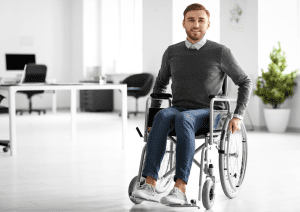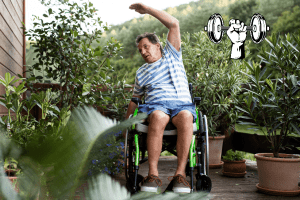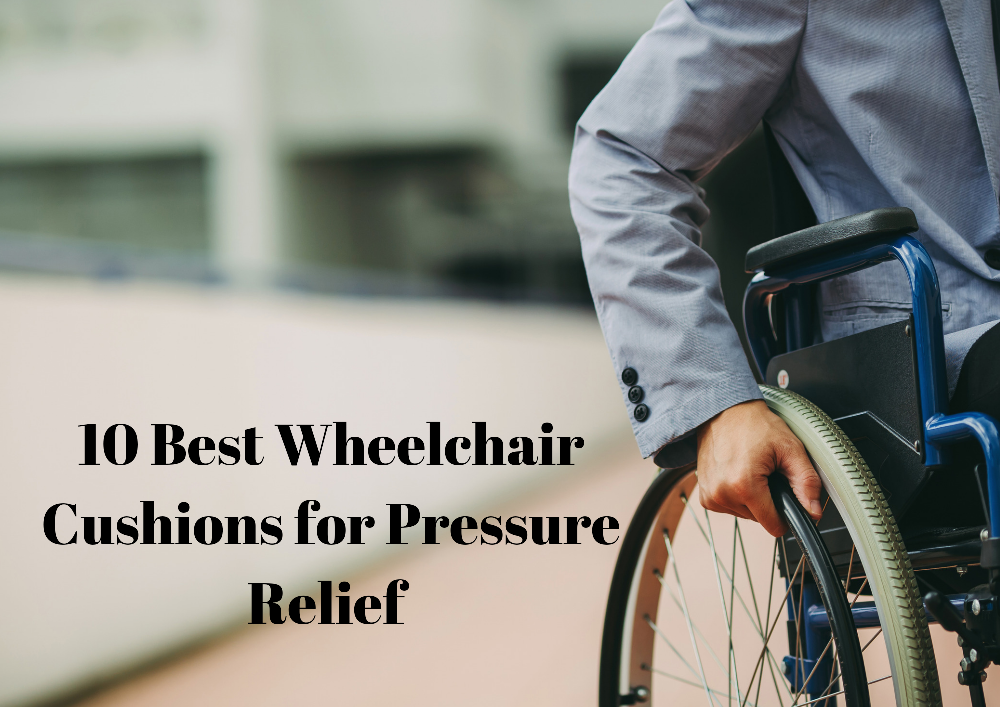
By Scihealthhub – December 27, 2024
In this guide, we’ll dive deep into the best wheelchair cushions for pressure relief, what to look for when choosing one, and how they help prevent pressure sores.
People who spend long hours seated in a wheelchair can experience pressure buildup in the buttocks and tailbone areas of the body. This can lead to skin breakdown in these areas, which can progress to dangerous pressure sores.
In order to prevent this problem, pressure relief through the use of appropriate wheelchair cushions and regular repositioning is critical.
Choosing the right wheelchair cushion can make a world of difference in comfort, health, and overall quality of life.
Each individual’s needs vary depending on factors such as body weight, skin condition, overall health condition, and wheelchair configurations. A healthcare provider or occupational therapist can help you determine the best wheelchair cushion for pressure relief based on these factors.
Why Pressure Relief Matters
Here are some of the reasons why you should invest in the right pressure relief wheelchair cushion.
Preventing Pressure Sores
Prolonged sitting, especially without adequate pressure relief measures, can reduce blood flow to the skin and underlying tissues, resulting in tissue damage and pressure (bed) sores. These sores are not only painful but can also lead to severe complications like infections, prolonged hospital stays, and, in extreme cases, life-threatening conditions such as sepsis. Using a pressure-relief cushion helps distribute weight evenly, significantly reducing the risk of these sores.
You might like to see our detailed article on The Fastest Way to Get Rid of Pressure Sores
Enhancing Posture
Pressure-relief cushions are designed to provide optimal support, encouraging spinal alignment and improved posture, thereby reducing the risk of complications like scoliosis and back pain.
Improving Circulation
Long-term sitting without movement can impair circulation, especially in the lower body. This increases the risk of swelling, discomfort, and a feeling of heaviness in the legs. A well-designed cushion redistributes pressure and allows for better blood flow and reduces the risk of these issues.
Reducing Pain
Many wheelchair users experience discomfort or pain due to prolonged sitting. High-quality pressure-relief cushions are crafted with materials such as gel, foam, or air cells that conform to the body’s shape, minimizing pain and enhancing comfort.
Key Features to Consider in a Wheelchair Cushion
When shopping for the right pressure relief cushion, it’s important to consider several features to ensure it meets your needs effectively. Here’s are features to consider:
Material:
The material of the cushion significantly affects comfort, pressure distribution, and durability. The options include gel, foam, air or combination.
Gel Cushions: Provide excellent pressure relief by conforming to your body shape. They are great for reducing heat buildup.
Foam Cushions: Affordable and lightweight, foam cushions offer firm support but may compress over time. High-density foam options are more durable and provide better pressure relief.
Air Cushions: Adjustable and lightweight, these cushions distribute weight evenly and reduce pressure points. However, they may require regular maintenance to prevent deflation.
Combination Cushions: These combine materials (e.g., foam and gel, foam and air) to offer the benefits of multiple technologies, ensuring optimal comfort and support.
Size and Fit:
Ensure the cushion matches and fits your wheelchair seat dimensions, and that it does not slide around. A poorly fitting cushion can reduce its effectiveness and compromise your posture. Measure your wheelchair seats length and width, and get a wheelchair cushion that closely matches those measurements.
Weight Capacity:
Each cushion has a specified weight capacity. Choosing a cushion that can comfortably support your body weight ensures durability and optimal pressure relief. Exceeding the weight limit may compromise the cushion’s performance and lifespan.
Portability:
If you frequently transfer between different chairs or travel often, a lightweight and portable cushion is essential. Some cushions come with handles or compact designs, making them easier to transport.
Maintenance:
Cushions should be easy to clean to maintain hygiene and prevent skin infections. Look for options with removable, machine-washable covers. Additionally, durable materials ensure the cushion can withstand daily use without degrading quickly.
Top 10 Wheelchair Cushions for Pressure Relief
1. ROHO High Profile Cushion
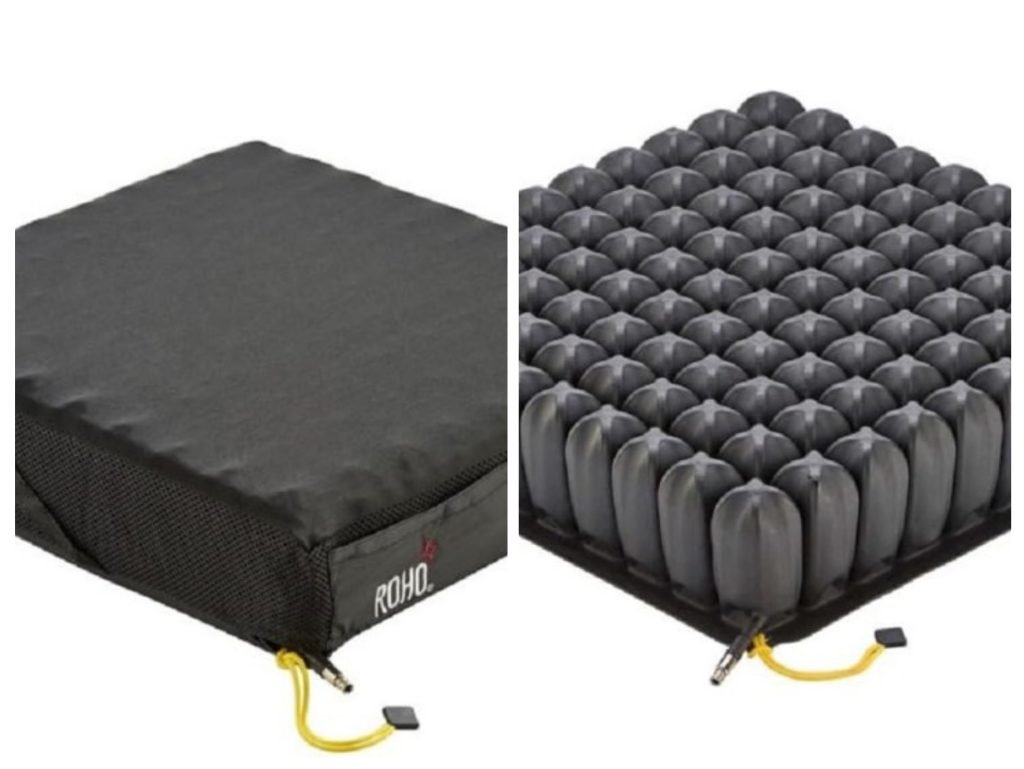
Material:
It is made of neoprene rubber, a durable, flexible, and moisture-resistant material. It features interconnected 4-inch air cells that allow for maximum immersion and pressure redistribution. The cushion comes with a breathable, washable cover for added comfort and hygiene.
Why It’s Great:
The cushion is highly regarded for its adjustability and ability to provide unparalleled pressure relief. Each air cell can conform to the user’s body shape, promoting even weight distribution and minimizing pressure points. This makes it one of the most effective solutions for preventing and managing pressure sores, even for long-term wheelchair users. Its lightweight design adds to its convenience.
Best For:
Individuals at very high risk of developing pressure sores.
People with existing skin breakdown or pressure injuries.
Users requiring maximum pressure redistribution for extended wheelchair use.
Pros:
Exceptional Pressure Relief: The deep air cells provide superior immersion and envelopment to reduce pressure points.
Customizable: Air levels can be easily adjusted to meet individual needs.
Skin Protection: Protects against shear and friction forces.
Lightweight and Portable: Despite its durability, it is easy to transport and install.
Durability: Neoprene material ensures long-term use with proper care.
Cons:
High Maintenance: Requires frequent air level adjustments to maintain effectiveness.
Cost: One of the more expensive wheelchair cushions.
Stability Concerns: The air cells may feel less stable for users unaccustomed to fully air-based cushions.
Weight Limit: May not be suitable for users above a certain weight capacity.
2. Jay J3 Cushion
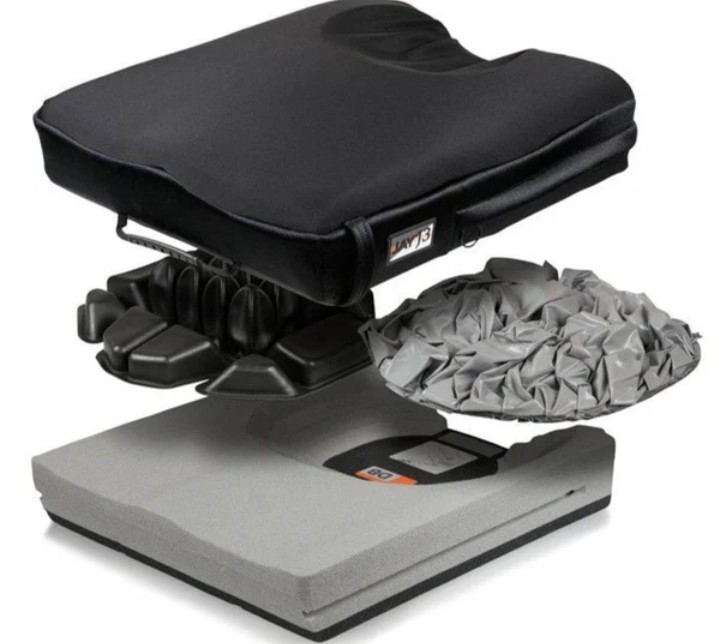
Material:
The Jay J3 Cushion is made of a multi-layered foam base, designed to provide stability and durability. It incorporates customizable components, including gel, fluid or air inserts, to enhance pressure redistribution. The cover is available in moisture-resistant, stretchable, or anti-microbial options, offering both comfort and hygiene for long-term use.
Why It’s Great:
The Jay J3 Cushion stands out because of its modular design that can be tailored to an individual’s specific needs. It provides excellent skin protection, pressure relief, and postural alignment, making it one of the most advanced wheelchair cushions on the market. The combination of contouring and customizable inserts ensures optimal support for users with complex seating requirements.
Best For:
Users at very high risk of pressure sores or with existing skin breakdown.
Individuals with pelvic obliquities, spinal deformities, or other postural asymmetries.
Long-term wheelchair users who require customized positioning and support.
People with complex seating needs, including those requiring high levels of stability and comfort.
Pros:
Highly Customizable: Modular components allow for precise adjustments to meet individual needs.
Exceptional Pressure Relief: Optional gel, fluid or air inserts offer superior protection against pressure sores.
Advanced Postural Support: The contoured design enhances pelvic stability and alignment.
Durable Materials: High-quality foam and cover options ensure longevity and ease of maintenance.
Variety of Sizes and Configurations: Accommodates a wide range of body shapes and wheelchair types.
Cons:
Cost: The high level of customization and advanced features make it more expensive than standard cushions.
Weight: Slightly heavier than simpler cushions due to its multi-layered design.
Complex Setup: Requires professional assessment and fitting to optimize performance.
Maintenance: The gel, fluid or air inserts may require occasional adjustments to maintain effectiveness.
3. Ease Cushion®: Alternating Pressure Cushion
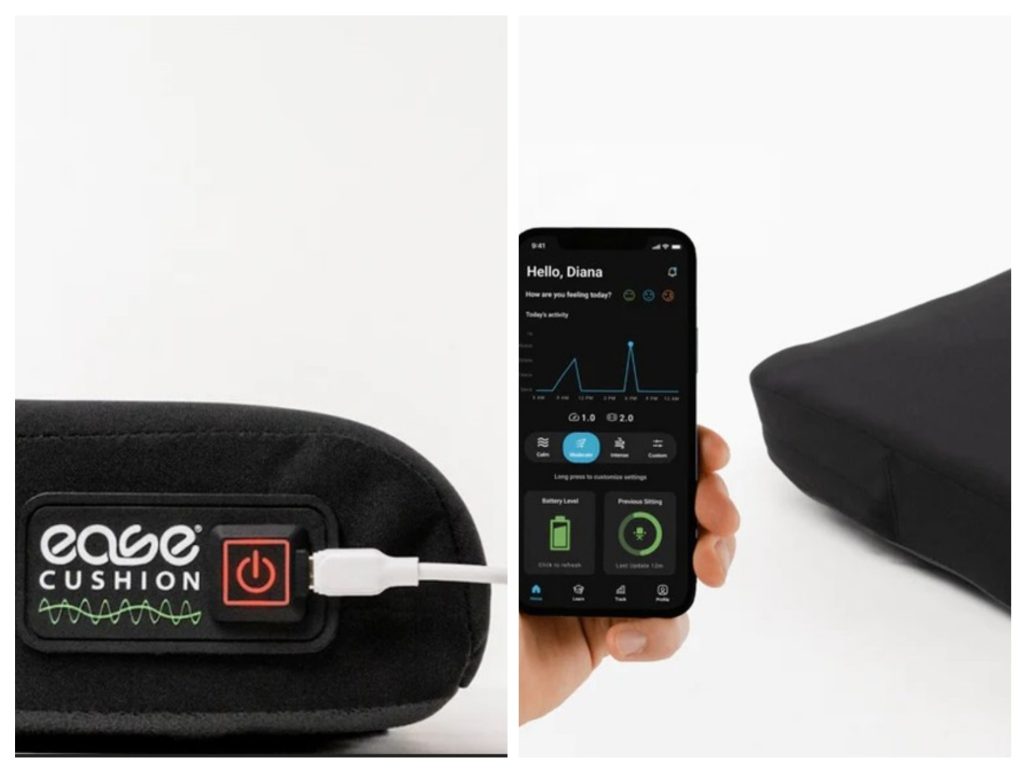
Material:
It combines a contoured foam base and air cells with an electronic air pump that redistributes pressure throughout the cushion, relieving pressure and promoting healthy circulation.
Why It’s Great:
It features an advanced software-driven Horizontal Alternating Pressure Technology (HAPT) that changes pressure in one-minute cycles, causing automatic lifts and shifts. It’s lightweight, portable, and designed for prolonged sitting, making it ideal for wheelchair users. It is an FDA-registered device designed for the treatment and prevention of pressure sores. The cushion settings can be customized via an app in your smartphone.
Best For:
Individuals at very high risk of pressure sores.
Wheelchair users who spend extended periods sitting.
Post-surgery patients requiring effective pressure management.
Pros:
Reduces the risk of pressure sores with alternating pressure technology.
Comfortable and supportive for prolonged sitting.
Easy to clean and maintain.
Lightweight and portable, suitable for travel.
Adjustable settings to cater to individual needs.
Cons:
May require regular maintenance of the pump system.
Relatively expensive compared to standard cushions.
Can be noisy due to the pump, potentially causing discomfort in quiet environments.
Limited battery life if used in portable mode.
4. Vicair Vector O2 Wheelchair Cushion
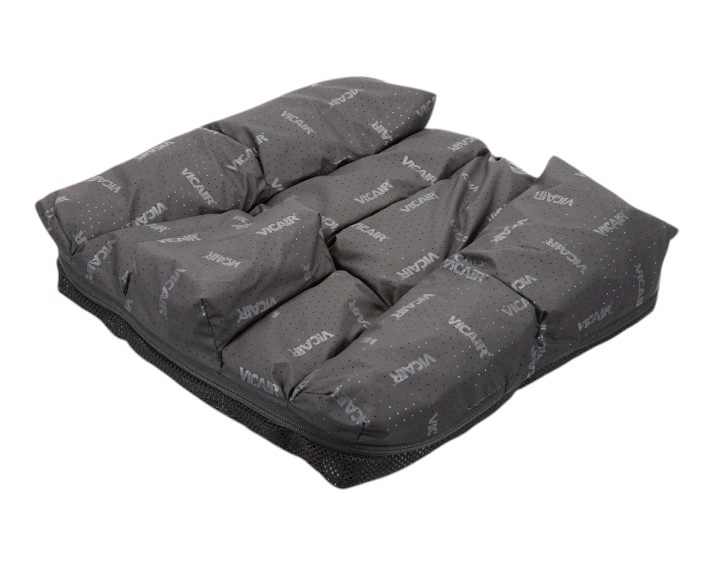
Material:
It is composed of hundreds of SmartCells, which are small, air-filled, adjustable, tetrahedron shaped pockets made from durable, lightweight material. These cells are strategically placed within multiple compartments to provide optimal pressure relief, support, and positioning. The cushion comes with a removable, breathable, and water-resistant cover that is easy to clean and maintain.
Why It’s Great:
The Vicair Vector is highly customizable and provides excellent pressure redistribution. The multi-compartment design allows for personalized adjustments, ensuring comfort and proper posture. It is particularly beneficial for users at high risk of pressure sores, as it minimizes friction and shear forces. Additionally, the cushion is lightweight and requires minimal maintenance compared to other air-based systems.
Best For:
Individuals at high risk of pressure sores.
Users with complex positioning needs, including those requiring pelvic support or postural stability.
Wheelchair users seeking a lightweight, low-maintenance cushion with excellent pressure relief.
Pros:
Pressure Redistribution: The SmartCells technology ensures even weight distribution.
Adjustable Design: Multiple compartments allow for personalized positioning.
Lightweight: Easy to handle and reduces the overall weight of the wheelchair.
Low Maintenance: Does not require frequent inflation checks like other air-based cushions.
Durable Cover: Water-resistant and easy to clean, ensuring hygiene.
Cons:
Cost: Higher price point compared to standard cushions.
Learning Curve: May require professional assistance to adjust and optimize settings.
Firmness: Some users might find it less soft compared to foam or gel cushions.
5. Jay J2 Cushion
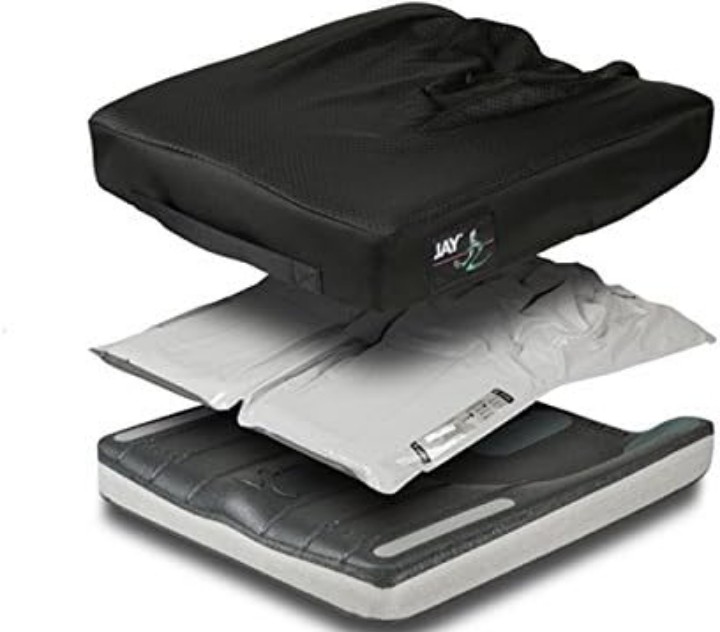
Material:
Features a contoured foam base, providing firm support and stability, and a soft, pressure-relieving gel insert helps to reduce the risk of pressure sores. The outer cover is often made of a durable, water-resistant, and breathable fabric that ensures easy cleaning and comfort.
Why It’s Great:
The Jay J2 Cushion is renowned for its ability to provide excellent positioning and pressure relief. The combination of a contoured base and gel insert allows it to accommodate a variety of postures and redistribute pressure evenly.
Best For:
It is ideal for individuals at high risk of developing pressure sores.
Users requiring advanced positioning support.
Those who spend extended hours in a wheelchair.
Pros:
Exceptional pressure relief due to the gel insert.
Contoured design enhances posture and positioning.
Durable and easy-to-clean cover.
Customizable features for specific user needs.
Proven track record for users with complex seating requirements.
Cons:
Heavier compared to other cushions due to the gel components.
Higher price point may not be budget-friendly for everyone.
Requires regular maintenance to ensure the gel insert remains effective. Regularly check for where the gel feels too thin or displaced and use your fingers to gently knead or smooth the gel layer back into an even position.
6. ROHO Mosaic Wheelchair Cushion
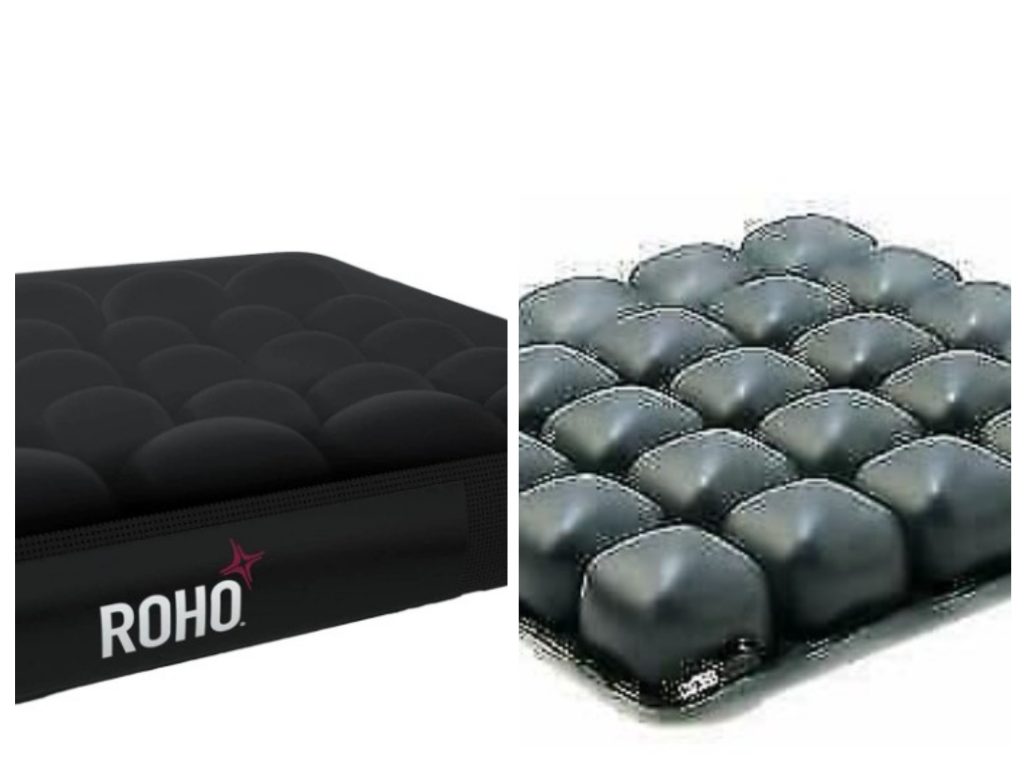
Material:
It features lightweight, 3″ air-filled cells made from durable, pliable material, typically polyvinyl chloride. These interconnected air cells adapt to the user’s shape, evenly distributing pressure. It also has a non-skid cover.
Why It’s Great:
The Mosaic cushion stands out for its simplicity, affordability, and effectiveness in providing basic pressure relief. Its air-cell technology adjusts to body contours, minimizing pressure points and reducing the risk of pressure sores. It’s easy to inflate and adjust, allowing users to customize the level of support and comfort.
Best For:
This cushion is ideal for individuals with low to moderate risk of pressure sores or those seeking an affordable option for general comfort and skin protection. It’s suitable for both temporary and long-term wheelchair users who require a lightweight and portable solution.
Pros:
Lightweight and easy to carry.
Customizable inflation for personalized support.
Budget-friendly compared to other ROHO models.
Easy to clean and maintain.
Provides effective pressure redistribution.
Cons:
May not provide sufficient support for users at high risk of severe pressure ulcers.
Air cells can be prone to punctures or leaks if not handled carefully.
Requires regular inflation checks to maintain optimal performance.
Limited in size options compared to other ROHO products.
7. ROHO Airlite Wheelchair Cushion
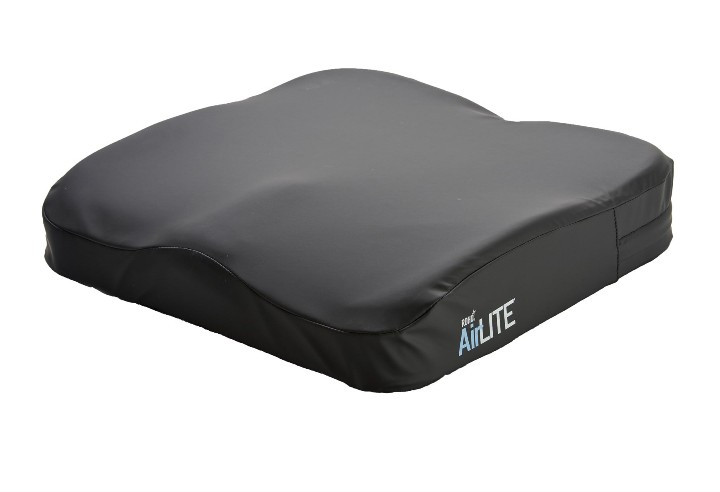
Material:
The cushion is made with a combination of lightweight polyurethane foam and an air-filled insert. This unique hybrid design provides both pressure relief and postural support. The cover is made from a durable, stretchable material that resists moisture and is easy to clean.
Why It’s Great:
The ROHO Airlite Cushion combines the best of foam and air-cell technology to provide exceptional comfort, pressure redistribution, and stability. Unlike fully air-filled cushions, it requires minimal maintenance while offering reliable pressure relief, making it a convenient option for users with moderate risk of developing pressure sores.
Best For:
Individuals at low to moderate risk of pressure sores.
Users who prefer a lightweight and low-maintenance cushion.
Those who need a cushion suitable for everyday use in manual or powered wheelchairs.
Pros:
Pressure Relief: The air insert reduces the risk of pressure sores.
Lightweight Design: Easier to handle and reduces the overall weight of the wheelchair.
Durability: Long-lasting materials ensure it stands up to daily use.
Low Maintenance: Unlike fully air-filled cushions, it doesn’t require frequent inflation checks.
Cons:
Limited Customization: Not as adjustable as fully air-filled cushions like ROHO High Profile or Low Profile cushions.
Moderate Risk Users Only: May not provide adequate pressure relief for individuals at high risk of developing pressure sores.
Foam Longevity: Over time, the foam layer may compress and lose effectiveness.
8. Supracor Stimulite Classic Wheelchair Cushion
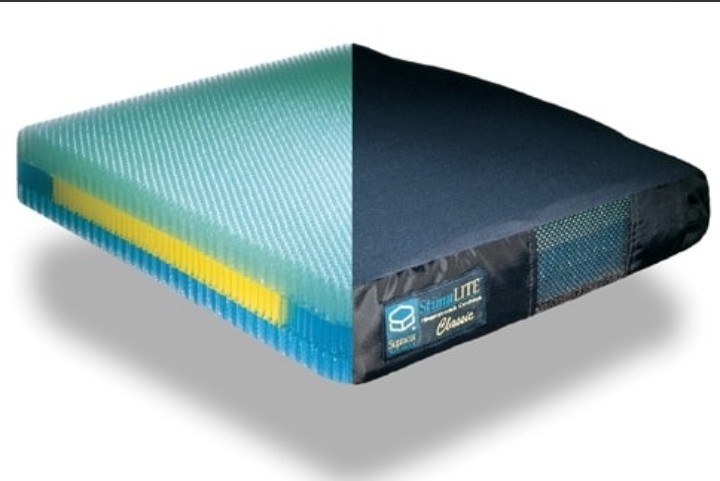
Material:
The cushion is constructed from a unique honeycomb-shaped, thermoplastic elastomer material. This innovative design promotes airflow, moisture control, and superior pressure redistribution. The material is lightweight, flexible, and hypoallergenic, ensuring comfort and durability. It also features a breathable, machine-washable cover for added convenience.
Why It’s Great:
The Supracor Stimulite Classic Cushion stands out for its honeycomb structure, which provides excellent pressure relief and ventilation. The cushion conforms to the user’s body to evenly distribute weight, reducing the risk of pressure sores. Its lightweight and low-maintenance design make it ideal for individuals seeking a balance of comfort, support, and hygiene.
Best For:
Individuals at moderate to high risk of pressure sores.
Wheelchair users requiring a lightweight, breathable cushion for daily use.
People who value easy cleaning and hygiene in their seating solution.
Pros:
Pressure Relief: The honeycomb design redistributes weight effectively, reducing pressure on key areas.
Breathability: Promotes airflow, preventing heat and moisture build-up.
Hygienic: Washable and hypoallergenic, making it ideal for individuals with sensitive skin.
Lightweight and Durable: Easy to handle and designed for long-term use.
Eco-Friendly: Made from recyclable materials.
Cons:
Firmness: May feel too firm for users accustomed to softer cushions.
Price: Higher cost compared to standard foam or gel cushions.
Limited Adjustability: The cushion’s design doesn’t allow for personalized pressure adjustments.
9. Kieba Gel Cushion
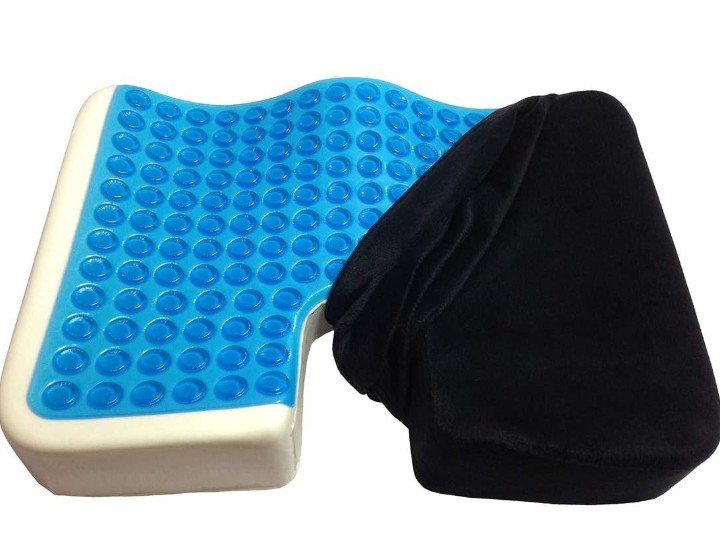
Material:
Why It’s Great:
This cushion combines the softness of memory foam with the cooling and pressure-relieving properties of gel. Its ergonomic design helps reduce pressure on the tailbone and lower back, making it ideal for prolonged sitting. The lightweight, portable design ensures versatility for use in wheelchairs, office chairs, or car seats.
Best For:
Individuals seeking relief from tailbone pain, sciatica, or lower back discomfort.
People who sit for long hours, such as wheelchair users, drivers, or office workers.
Those looking for a low-maintenance, affordable cushion with moderate pressure relief.
Pros:
Pressure Relief: The gel layer redistributes pressure, reducing discomfort in key areas.
Cooling Gel: Prevents heat build-up for enhanced comfort.
Portable and Lightweight: Easy to carry and use across multiple settings.
Durable Cover: Non-slip and machine-washable for hygiene and convenience.
Affordable Price Point: A cost-effective solution for comfort and moderate pain relief.
Cons:
Limited Pressure Redistribution: May not be sufficient for individuals at high risk of developing pressure sores.
Thickness: The cushion might feel bulky on some surfaces or in tighter seating spaces.
Durability of Gel Layer: The gel layer may degrade over time with heavy use.
10. ROHO Enhancer Cushion
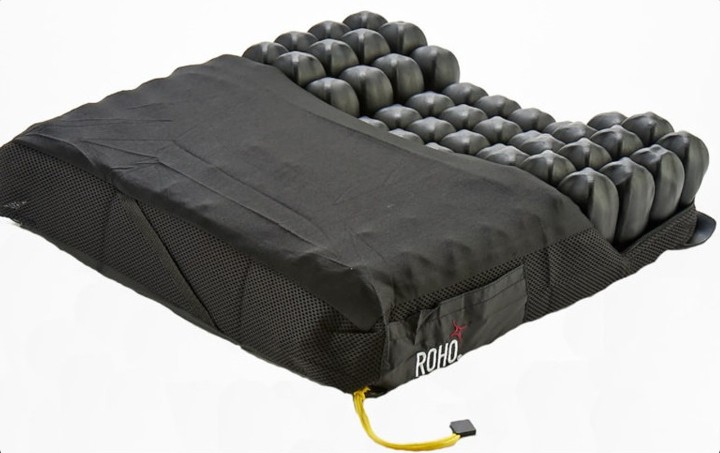
Material:
It is made from interconnected neoprene air cells, which can be adjusted to suit individual needs. The cushion features two separate air chambers, allowing for tailored support and pressure redistribution. Its durable, stretchable cover is breathable, easy to clean, and designed to resist moisture buildup.
Why It’s Great:
The ROHO Enhancer Cushion is renowned for its customizable pressure relief and positioning support, thanks to its dual air chambers. The cushion adjusts to the user’s body shape, minimizing friction and shear forces. Its unique contoured design promotes pelvic stability and improved posture, making it ideal for individuals with complex seating needs or high risk of pressure sores.
Best For:
Individuals at high risk of pressure sores due to limited mobility.
Wheelchair users needing pelvic support, postural alignment, and excellent pressure redistribution.
Those who require a lightweight, portable cushion with adjustable support.
Pros:
Customizable Pressure Relief: Dual air chambers allow for personalized adjustments.
Pelvic Stability: Contoured design enhances positioning and postural support.
Durability: High-quality neoprene material ensures long-term use.
Lightweight: Easy to handle and transport.
Hygienic Cover: Resistant to moisture and simple to clean.
Cons:
Cost: Higher price point compared to standard cushions.
Maintenance: Requires regular inflation checks and adjustments.
Learning Curve: Adjusting the air chambers correctly may require professional guidance.
Firmness: May feel less soft compared to foam or gel cushions.
Conclusion
Finding the best wheelchair cushion for pressure relief is a vital step toward enhancing comfort, health, and independence. Whether you’re at risk of pressure sores or simply seeking better comfort, there’s a cushion out there to meet your needs. Explore the options, consult a specialist, and make an informed decision.


